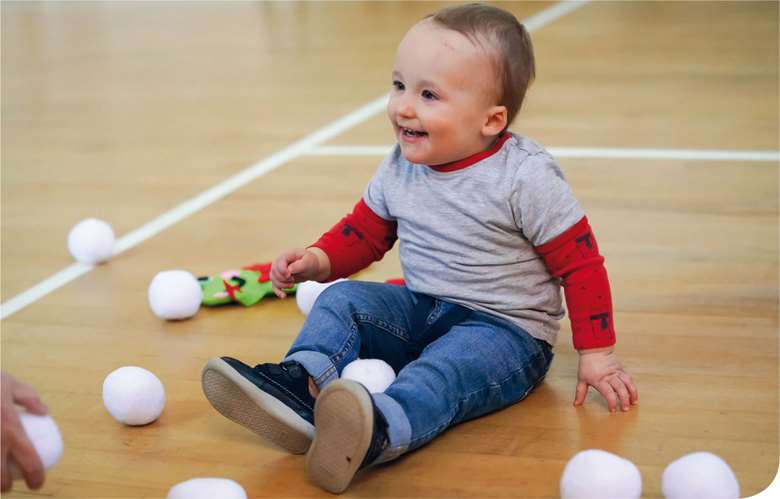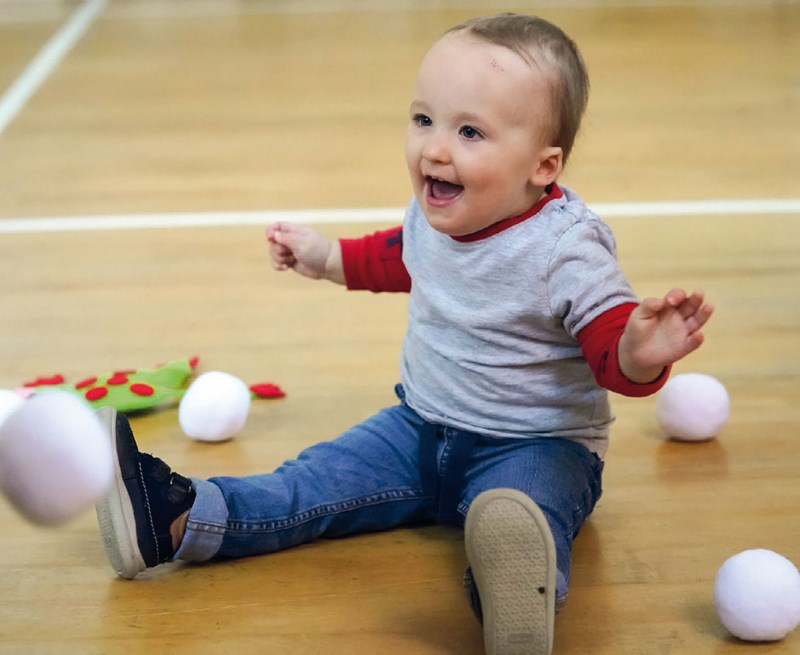Music for all: Early Years music for SEND
Cameron Bray
Saturday, February 1, 2020
Cameron Bray offers some thoughts and suggestions for resources to help develop music activities for young children who may also have additional needs.

Much has been made of the benefits of music to children at early years. Indeed, if we ever get a follow-up to the National Plan for Music Education, which was only intended to run until 2020, it is widely hoped that music education will finally receive funding from birth, rather than the current starting age of five. Introducing developing minds to music can have innumerable benefits for wellbeing and educational development and, unsurprisingly, the same holds true if the child in question is disabled.
While the term SEND is a well-meaning attempt to capture the complexity of the human condition, it doesn't convey much in the way of useful information, and groups together mild behavioural difficulties with physical disabilities that require a high level of support. In Scotland, the even broader term of ‘additional support needs’ (ASN) is used, and includes children whose education may be impacted by factors such as being bullied, bereaved, in foster care, or a teenage parent. In this article, I will be speaking specifically about disability rather than other educational needs, though the term SEND will be used occasionally.
As a trustee of Drake Music (www.drakemusic.org), I'm lucky to be part of an organisation that is pushing the boundaries of what is possible regarding accessibility to music. While talking about disability can make people feel uncomfortable, the approach that Drake Music takes is to speak about it openly and with curiosity. By doing this, you start to consider how you can offer meaningful support and education. What follows shouldn't be taken as a comprehensive guide but rather a starting point for anyone looking to widen their pool of pupils, regardless of your current approach.
Ask the experts
Clare Seymour is a musician, educator and psychologist. She is also one of the founders of Musicbuds (www.musicbuds.org) which produces multisensory early years music resources, along with Anna Clow, an early years practitioner. In Seymour's experience, does a child's disability change what age they can be introduced to music-making?
‘Not really, depending, obviously, on the disability itself,’ says Seymour. ‘Provided we are responsive, creative, flexible and sensitive, we can introduce music-making from birth or even sooner – the human foetus hears and responds to sounds from about 25 weeks. Wherever possible, our interactions should encourage the individual to take the lead.’
This person-centred approach is also advocated by ABC Creative Music (www.abccreativemusic.com), a developer of innovative cost-effective nursery, primary and ASN/SEND music programmes led by Phil and Tom Bancroft. Recently, it won the 2018 Teach Early Years Award for Early Years Music Resources, and it's clear from going through the material that this work holds ‘creativity and interactivity as its core philosophy’, as Phil puts it.
‘My brother and I are both jazz musicians,’ says Phil. ‘We trained in medicine and we started looking at approaches to creativity and how to teach it. We developed a model of what that means in music, and an approach to teaching creativity that developed creative mental skills that are really very simple.
‘After we had been going for quite a while and established ourselves, we were asked to develop an early years resource inspired by the “communicative musicality” work of Malloch and Trevarthen at the University of Edinburgh. That work is about the two-way creative relationship that exists between young babies and their mothers. It frames musical creativity right at the centre of development, right at the beginning of social relationships, and makes it a very universal thing in human development that explains a lot of things.
‘We were very inspired by that work and focused on developing a cross-curricular resource. Different parts of the curriculum are touched by it, but at the centre of it is an approach to musicality and creativity – those things that are a variable to all children, all brains, whatever levels they're at. We've been able to adapt those resources to be used in SEND settings for children of a range of ages, from early years to secondary.
‘Most SEND educators will talk about this idea of “spiky profiles” so that each child has a blend of cognitive ability, language and communication ability, physical abilities, social ability, behavioural issues. At early years, you're trying to target activities and shape them for individual children's brains. The way we see it is that the framework of creativity in music education – education in general – makes for very sensory and engaging experiences. If a resource or an activity is designed with creativity in mind then, almost by definition, it must be putting the child at the centre.’
Evolving your practice
So how exactly do you put the child at the centre of your work? To start with, it's important to consider your current capacity, and whether or not you are actually able to provide teaching to disabled children that is of a comparable quality to the rest of your teaching.
You might feel that some additional training would be beneficial. Your local music education hub may deliver this itself, or in partnership with an organisation such as Drake Music, which runs a number of courses aimed at improving accessibility through technology and changing practices. Should it prove difficult to access training, there might be existing groups in your area that would welcome you and offer an opportunity for shadowing.
A common problem is workshops labelled as suitable for disabled children, which are often only able to support a narrow set of disabilities. This can lead to embarrassment on the part of the pupil and their family, as well as the teacher – though one of the advantages of working at early years is that it is far more common for adults to take part in the activity as well, which should make things easier. Another way round this is to make it clear exactly what you are offering, which should help parents and carers work out if it is suitable for their child. Make sure to keep the description as simple as possible. In my experience, parents and carers of disabled children are less likely to have the time and energy to digest complex information.
It is worth taking an honest approach regarding your capacity and weighing it up against the sort of work that you want to do. Have a think about whether there are particular areas of disability you would like to focus on, if there are any specific needs in your community which aren't being met, and if you're intending to go it alone or work with other musicians.

When it comes to content, there are two broad categories to consider: traditional instruments and music technology. In the realm of traditional instruments, percussion is one of the more accessible methods of music-making, especially at early years, providing participants have some range of motion. If you're starting from scratch, it's worth checking out Consortium Education (www.consortiumeducation.com) which provides an incredibly wide range of accessible and sensory instruments, from bells to boomwhackers. At early years, when the brain is at its most elastic, using music to introduce a number of sensory experiences can improve cognitive and communication skills – think bright colours and instruments with interesting tactility.
Vocalisation shouldn't be overlooked either, as many children who find verbal communication difficult are able to articulate their emotions and needs through singing. Songs can be used to introduce routine and create expectations, which are useful for reducing stress in unfamiliar situations.
Technologically-driven music-making holds a great deal of potential with regards to increasing access. Last year, Open Orchestras was awarded this magazine's award for Outstanding SEND Resource for its Clarion instrument (www.openorchestras.org/instruments), a remarkable app that can be played by a huge amount of people thanks to its integration with touchscreen and eye-tracking software. It has many potential uses in early years/SEND music education, as does the Skoog family of instruments (skoogmusic.com). Both can be explored through a wide range of resources provided by their creators.
If this sounds wonderful but a little out of your budget, it might be worth looking into Drake Music's training course, ‘Approaches to accessible music-making’, which is specifically designed to teach musicians how to remove disabling barriers without needing to invest in prohibitively expensive equipment. Though there is a price tag attached to this, if you're working (or intending to work) with a lot of children then it might work out more cost effective than purchasing a single piece of equipment which then needs to be rationed. The training will equip you with the knowledge you need to incorporate microphones and switches into an accessible music-making toolkit – you've not lived until you've played a song on a banana keyboard!
Technology allows us to imagine and create bold new instruments that might only be of use to a single person. With the right approach, you might find a way of unlocking access to music-making for someone who would otherwise have been a passive participant. I believe that music-making has a fundamental role to play in everybody's life, but not as some kind of curative for disability. Though it's true that many of the benefits of music education, such as increased communication and social skills, can improve the lives of disabled people, I don't think those features are what make a music education worthwhile for anybody. Instead, it is music's capacity to be enjoyed that I celebrate, as well as the simple ways in which it can bring everyone together. If we start from the assumption that everyone deserves the opportunity to join in the song, standards of music education will rise for everybody, and we may even start to see better representation of disability in both music education and the wider arts scene. That can only happen with your help.
Clare Seymour's advice for early years SEND music lessons
Prepare the session in absolute detail, then think a little about expecting the unexpected! Four areas to bear in mind:
Planning: The objective, the environment, behaviour management, and any support you might need.
Rehearsing: Practise and prepare the material, instruments, props, your delivery, positioning, and planned interactions.
Problem-solving: Think about ‘what if…’ and have extra plans in place.
Reflecting: Am I providing a balanced set of musical experiences in a calm and positive atmosphere?
In terms of content, a core element for early years SEND learning is pulse. I am passionate about establishing and maintaining a consistent pulse. This internal timing/synchronisation is vital to both development and functioning in all aspects of our lives. Also, aim to simultaneously deliver the following three elements:
Musical: Concentrate on the building blocks of music, with pulse at the forefront.
Holistic: Always consider the complete experiential aspect of the child – never try to separate music out.
Reflective: Does the session offer breadth? Balance? Repetition? Originality?
For more information, check out the Musicbuds blog written especially to tie in with this article (www.musicbuds.org/blog-news). The full range of Musicbuds resources can be found for sale on the same website.
Top Tips
- Never make assumptions about a disability
- A little research can go a long way
- Be open to experimentation – it might take a while to find the ‘right’ approach
- Don't try and be everything to everyone
- Share your experience and knowledge with others
- Be critical about your expectations of your pupils – are you too ambitious or not ambitious enough?
- Create a one-page form for parents and carers to tell you what music their child likes
- Simplify information for parents and carers
- Discuss expectations with parents and carers, and work with them to plan and evaluate
- Make sure you are enjoying your work and having fun

